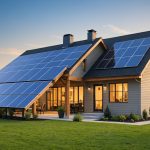Overview of Smart Home Technology and Energy Management
Smart home technology integrates various devices and systems to automate and control different aspects of a home, contributing significantly to energy management. Essential components include smart thermostats, lighting, and appliances, all connected through the Internet of Things (IoT) to enhance operation efficiency.
Energy management systems (EMS) are pivotal in optimising energy use in households. They monitor, control, and conserve energy consumption by analysing past data and predicting future needs. These systems are capable of adjusting energy usage dynamically, based on user preferences and external factors like weather conditions.
This might interest you : Explore the benefits of intelligent lighting solutions for uk urban environments
Recent statistics indicate substantial energy cost reductions attributed to smart technologies. According to industry reports, implementing smart home technology can yield energy savings of up to 30% on annual energy bills. For instance, smart thermostats alone can reduce heating and cooling costs by around 10-15%.
The integration of smart home technology and effective energy management not only contributes to cost savings but also promotes environmental sustainability. By maximising energy efficiency, households can substantially decrease their carbon footprint, supporting global energy conservation efforts.
Also read : Embrace tomorrow: explore cutting-edge innovations in home renewable energy solutions
Key Smart Home Devices for Energy Efficiency
Energy efficiency in homes is more attainable with the help of smart devices. These not only facilitate convenience but also contribute significantly to reducing energy consumption.
Smart Thermostats
Smart thermostats revolutionise the way we control our home’s climate. They learn users’ habits, adjusting temperatures accordingly to optimise energy use. For instance, they lower heating when the house is empty. A key feature includes remote control, allowing adjustments even when away from home, and scheduling capabilities for efficient energy management. Numerous case studies highlight significant energy savings, showing reductions in heating bills by up to 30%. Smart thermostats are intelligent investments for sustainable living.
Smart Lighting Systems
The benefits of smart lighting systems extend beyond mere convenience. They contribute majorly to energy savings through features like automated dimming and motion sensors. These systems detect when rooms are empty, automatically turning off lights, thus saving electricity. The technology ensures optimal brightness while reducing energy consumption, with examples showing a notable drop in utility costs. Such systems exemplify how smart lighting can be both eco-friendly and cost-effective.
Smart Power Strips and Outlets
Smart power strips prevent energy wastage from plugged-in devices. Offering control via apps, users can monitor energy use, turning off outlets remotely to save on electricity costs. Users report marked declines in monthly bills, underscoring the financial advantages of these smart solutions. These devices are crucial for an energy-efficient home.
Strategies for Implementing Smart Home Technology
Implementing smart home technology can be a game-changer in managing your home’s energy consumption and cutting energy costs. Start by assessing your home’s energy needs. This involves understanding current usage and identifying high-energy-consuming areas.
Next, consider the potential savings your home could achieve. This will help prioritize which smart devices to implement. For example, if heating costs are significant, a smart thermostat might be a lucrative investment.
Integration of these devices into existing systems requires careful planning. Ensure compatibility with your current setup. Begin with simpler strategies, such as smart lighting, before moving to more complex systems like smart HVAC controls.
A crucial element in this process is energy monitoring. By tracking usage data, you can measure the improvements and validate cost reductions. Real-time monitoring gives immediate feedback, helping fine-tune settings for optimal performance and saving even more.
By following these implementation strategies, you leverage technology to enhance efficiency while promoting sustainability in your home environment. Always keep the focus on practicality and benefits, enabling you to make informed decisions about smart home investments.
Comparing Technologies and Cost-Benefit Analysis
Smart home technologies offer a myriad of options, each with unique benefits. Understanding how these technologies stack up can help guide better decisions for homeowners.
Overview of Different Smart Technology Solutions
With technologies like smart thermostats, lighting, and security systems, comparing these options can feel overwhelming. Technology comparison is crucial in making informed investments. Start by analyzing the upfront costs against anticipated long-term savings. For instance, while a smart thermostat may require initial investment, its energy-efficient features often lead to substantial savings over time.
Often, the best device depends on specific needs. For instance, if energy efficiency is a priority, investing in smart lighting systems could yield the highest return.
Evaluating ROI of Smart Home Investments
Determining the return on investment (ROI) requires evaluating several criteria. Consider factors like energy savings, increased home equity, and enhanced security. While cost reduction is a primary benefit, smart home technologies also promise non-monetary gains such as convenience and peace of mind.
Real-world examples illuminate these benefits. A smart thermostat user might report significant budget reductions during winter months, illustrating a successful investment. Ultimately, thorough cost-benefit analysis can lead to more strategic and satisfying decisions in the realm of smart home technologies.
User Experiences and Case Studies
Exploring real-life examples offers valuable insights into how energy-saving technologies impact daily life. Multiple case studies document significant energy savings. For instance, a family in London reduced their electricity bill by 30% after implementing smart meters. The device offered them precise usage data, empowering them to make informed adjustments to their consumption. This scenario exemplifies the merits of integrating technology for sustainable living.
Users have shared testimonials highlighting their experiences. Many report positive changes, such as enjoying reduced environmental footprints and lower utility expenses. One user expressed sheer satisfaction, noting, “I never realised how much energy I wasted. These changes have alleviated anxious thoughts about my energy consumption.”
From these user experiences, several lessons have been learned. A common tip is to start with small adjustments to ease the transition into energy-saving habits. Users recommend regularly reviewing energy data and involving everyone in the household to achieve optimal results. Such firsthand accounts underline the practicality and feasibility of adopting energy-saving technology for both novices and seasoned users alike. As these stories illustrate, embracing technology can lead to both economic benefits and a more sustainable lifestyle.
Future Trends in Smart Home Energy Management
As we look to the future, technological advancements are poised to significantly enhance smart home energy management systems. One of the most promising future trends is the integration of artificial intelligence in managing home energy consumption. AI can optimise energy use by predicting the best times to utilise grid energy versus stored solar power, providing a more efficient and sustainable solution.
Sustainable energy solutions are also set to transform smart homes with innovations such as smart thermostats and adaptive lighting systems. These devices adjust their operations based on occupancy and time of day, ensuring minimal energy wastage without compromising comfort. Moreover, advancements in home battery storage will make it possible to store more renewable energy, reducing reliance on non-renewable sources.
Predictions for the future of energy management centre around increased connectivity and automation. Smart homes will likely synthesise data from multiple devices to create a cohesive energy management strategy. This holistic approach not only reduces energy costs but also decreases the household’s environmental footprint.
In summary, the role of sustainability in future smart home innovations can’t be overstated. As technologies continue to evolve, they offer new paths towards energy-efficient living, aligning with a greener global future.











